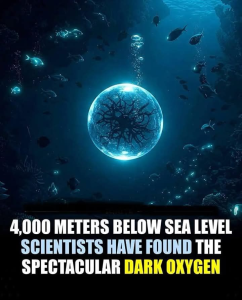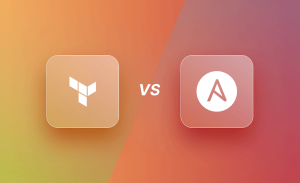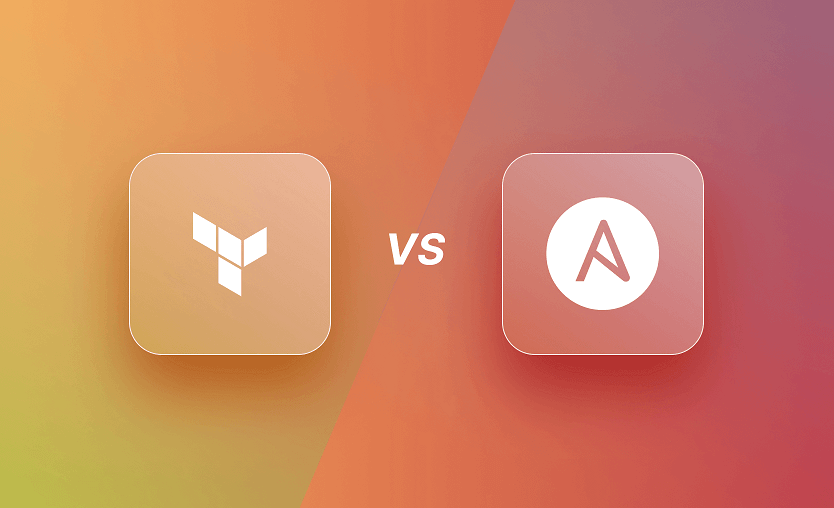
Introduction
In the fast-paced world of DevOps and cloud infrastructure, tools like Terraform and Ansible are widely regarded as key players in automating and managing infrastructure. While both are crucial in their own right, they serve distinct purposes, and their use cases differ significantly.
In this blog post, we’ll explore the differences and similarities between Terraform and Ansible, highlight their strengths and weaknesses, and offer recommendations on how to best use these tools for infrastructure and configuration management.
What is Terraform?
Terraform, developed by HashiCorp, is a powerful Infrastructure as Code (IaC) tool that enables the provisioning, managing, and deploying of infrastructure. It employs a declarative syntax called HashiCorp Configuration Language (HCL), allowing users to define their desired infrastructure state.
Key Features of Terraform:
- State Management: Tracks resources and configurations in state files, ensuring consistency.
- Declarative Code: Users declare the final state of infrastructure, and Terraform ensures alignment with the configuration.
- Reusable Modules: Infrastructure can be modularized for reuse.
- Cloud-Agnostic: Terraform supports over 3,000 providers, making it suitable for multi-cloud environments.
Terraform shines when it comes to provisioning infrastructure at scale, providing an efficient solution for Day 0 tasks.
What is Ansible?
Ansible, developed by RedHat, is a powerful automation and configuration management tool. Written in Python, Ansible uses a simple YAML-based syntax to define automation tasks. It is ideal for tasks like application deployment, OS configuration, and ongoing management of resources.
Key Features of Ansible:
- YAML Syntax: Human-readable, simple to write and manage.
- Playbooks: YAML files that express configurations and orchestrations in Ansible.
- Agentless: Uses SSH to connect to machines, requiring no additional agent installation.
- Roles and Modules: Modular and reusable code units that simplify automation.
- Cross-Platform: Works with any infrastructure, regardless of the operating system or cloud provider.
Ansible’s strength lies in its ability to manage configuration and automate deployment, excelling in Day 1 and Day 2 activities.
Terraform vs. Ansible: Similarities
- Provisioning: Both tools can provision cloud resources.
- Agentless: Neither requires an agent installed on target systems.
- Cloud Support: Both work seamlessly with all major cloud providers (AWS, Azure, Google Cloud, etc.).
- Masterless: They do not rely on master-slave architectures, simplifying setup and maintenance.
Terraform vs. Ansible: Key Differences
| Feature | Terraform | Ansible |
|---|---|---|
| Type | Orchestration tool | Configuration management tool |
| Syntax | HCL (HashiCorp Configuration Language) | YAML |
| Language | Declarative | Procedural |
| Default Approach | Immutable infrastructure | Mutable infrastructure |
| State Management | Tracks lifecycle via state files | No state management |
| Packaging/Templating | Partial support | Full support |
| Primary Use Case | Day 0 activities (Provisioning) | Day 1 and Day 2 activities (Configuration) |
| License | Business Source License (BUSL) | Open Source |
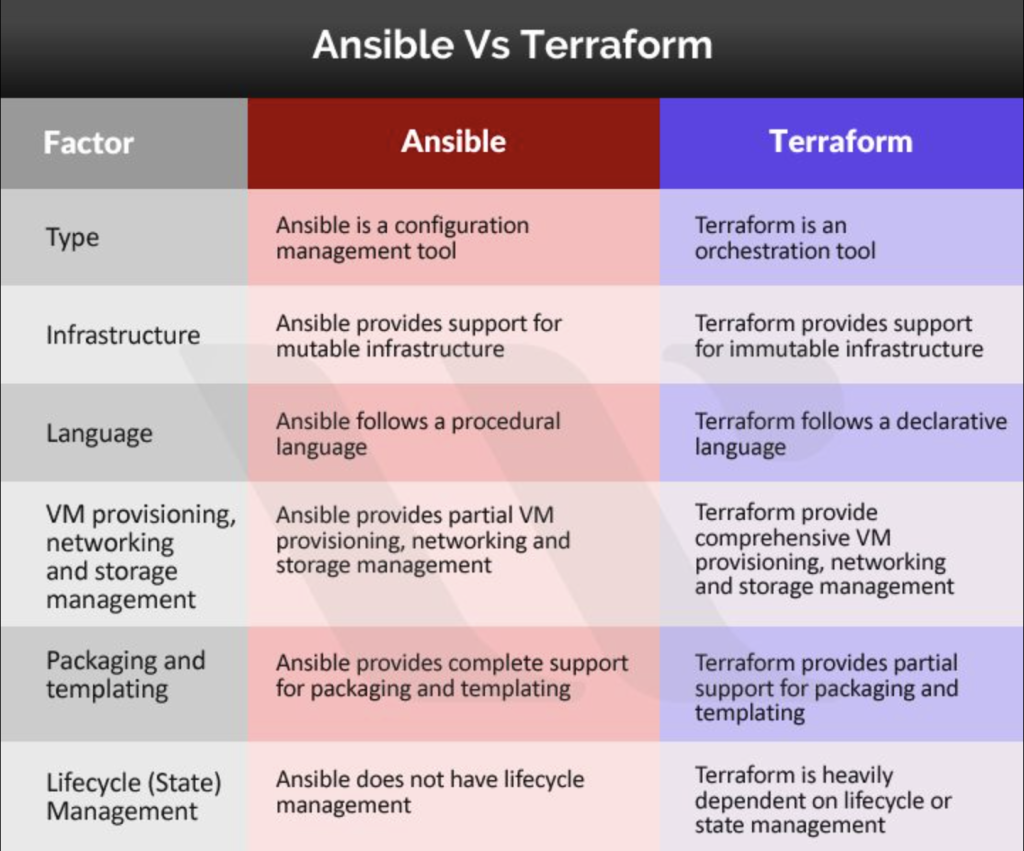
Detailed Comparison
1. Orchestration vs. Configuration Management
- Terraform is primarily designed for orchestration. It provisions and de-provisions infrastructure resources like virtual machines, networks, and databases through cloud provider APIs.
- Ansible excels in configuration management, automating tasks like software installation, OS updates, and network configuration.
2. Declarative vs. Procedural Language
- Terraform’s declarative HCL simplifies infrastructure management by focusing on the desired end state rather than the steps to achieve it. Dependencies are automatically managed.
- Ansible’s YAML is procedural, requiring tasks to be executed sequentially. This provides greater control but adds complexity for complex workflows.
3. Mutable vs. Immutable Infrastructure
- Terraform encourages immutable infrastructure, provisioning new resources for updates and decommissioning old ones. This reduces risks associated with configuration drift.
- Ansible supports mutable infrastructure, applying changes directly to existing resources, which can sometimes lead to inconsistencies.
4. State Management
- Terraform maintains a state file to track infrastructure resources, ensuring idempotency and consistency across deployments.
- Ansible does not maintain state, instead relying on idempotent tasks to manage configuration.
5. Configuration Drift
Terraform detects drift by comparing the current state with its state file and updates the infrastructure as needed. Ansible prevents drift through continuous execution of playbooks.
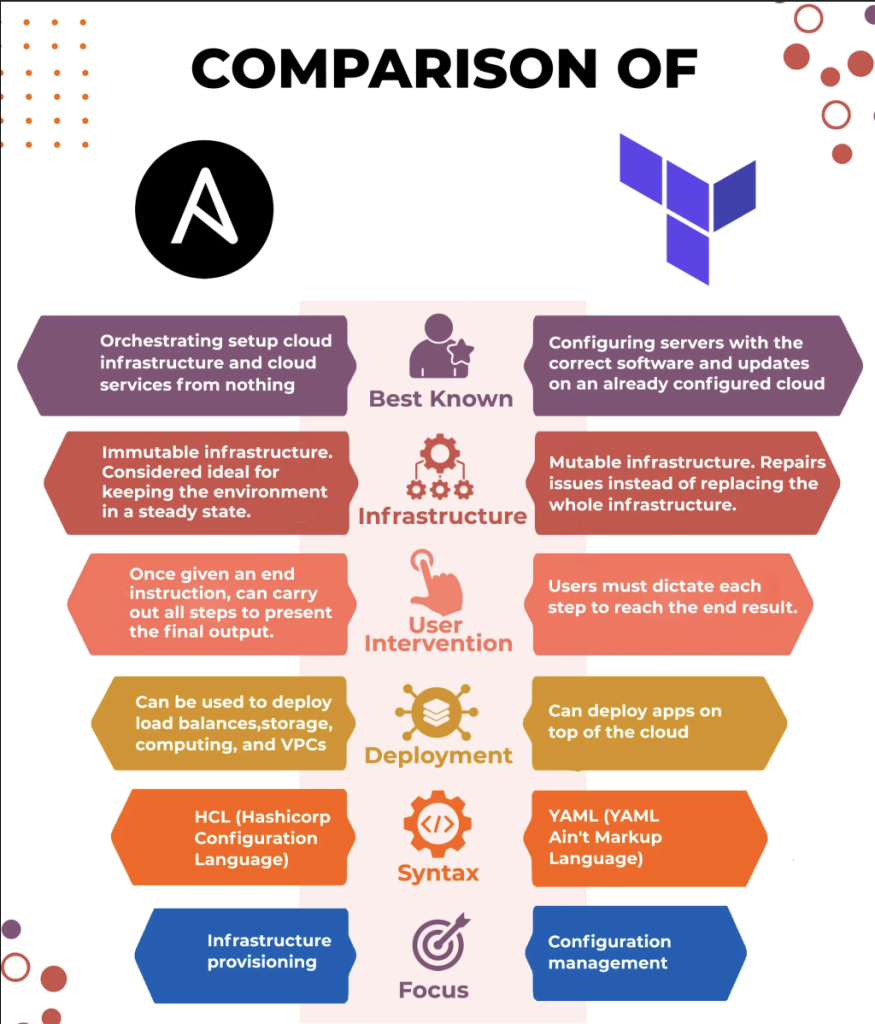
When to Use Terraform
Terraform is best suited for:
- Provisioning cloud infrastructure from scratch (Day 0 activities).
- Multi-cloud and hybrid-cloud environments.
- Managing infrastructure lifecycle.
- Blue/Green deployments for immutable infrastructure.
When to Use Ansible
Ansible is ideal for:
- Configuring operating systems and applications post-provisioning (Day 1 and Day 2 activities).
- Automating deployment pipelines.
- Managing dynamic environments requiring frequent changes.
- Continuous updates to applications and dependencies.
Best Practices: Combining Terraform and Ansible
Rather than choosing one tool over the other, it’s recommended to combine Terraform and Ansible for infrastructure management. This hybrid approach leverages their respective strengths:
- Use Terraform for Day 0 orchestration, such as provisioning cloud resources.
- Use Ansible for Day 1 and Day 2 configuration management, such as software updates and application deployments.
This strategy, often referred to as the Blue/Green deployment approach, ensures reliable provisioning and configuration while minimizing risks of failure.
Conclusion
Terraform and Ansible are both powerful tools in the DevOps ecosystem, each excelling in different areas of infrastructure management. Terraform is the go-to solution for infrastructure orchestration, while Ansible dominates configuration management.
For organizations managing complex cloud environments, leveraging both tools is the optimal strategy. By combining Terraform’s orchestration capabilities with Ansible’s configuration management strengths, teams can build scalable, reliable, and efficient infrastructure.
If you’re still unsure which tool suits your needs, consider the requirements of your workflow and the complexity of your infrastructure. And remember, combining Terraform and Ansible can often yield the best results.
Tags: Terraform vs Ansible, Infrastructure as Code, Configuration Management, Cloud Automation, Immutable Infrastructure, DevOps Tools, YAML vs HCL, Orchestration Tools, State Management, Blue/Green Deployment, Terraform, Ansible, Infrastructure as Code, Configuration Management, DevOps Tools, Immutable Infrastructure, Mutable Infrastructure, State Management, Orchestration, CI/CD Tools

